The formulation of the lysis solution in this kit is proprietary. However, it does not contain Trizol.
Kluczowe dokumenty
NA2110
GenElute™ Bacterial Genomic DNA Kits
sufficient for 70 purifications
Synonim(y):
Bacterial Genomic DNA, bacterial DNA prep, bacterial DNA purification kit, bacterial gDNA extraction kit, bacterial gDNA isolation kit, bacterial gDNA purification kit, bacterial genomic DNA extraction kit, bacterial genomic DNA isolation kit, bacterial genomic DNA purification kit, Gen Elute
Wybierz wielkość
1430,00 zł
Wybierz wielkość
About This Item
1430,00 zł
Polecane produkty
zastosowanie
sufficient for 70 purifications
Poziom jakości
metody
DNA purification: suitable
temp. przechowywania
15-25°C
Szukasz podobnych produktów? Odwiedź Przewodnik dotyczący porównywania produktów
Powiązane kategorie
Opis ogólny
The kit combines the advantages of a silica-based system with a microspin format and eliminates the need for expensive resins, alcohol precipitation, and hazardous organic compounds such as phenol and chloroform.
Zastosowanie
- restriction endonuclease digestions
- PCR
- Southern blots
- cloning
Cechy i korzyści
- Starting material: Up to 1.5 mL of culture
- Expected yield: Up to 20 μg
- Elution volume: 400 μl
- Time required: 70 - 120 min
- A260/A280 ratio: 1.6 - 1.9
- No phenol, chloroform, or ethanol precipitation required
Zasada
The expected yield of genomic DNA will vary depending on the cell density of the bacterial culture and the bacterial species and strain used. DNA purified with the GenElute kit has an A260/A280 ratio between 1.6 and 1.9 and can be up to 50 kb in length.
Inne uwagi
Informacje prawne
Elementy zestawu są też dostępne oddzielnie
polecane
produkt powiązany
Hasło ostrzegawcze
Danger
Zwroty wskazujące rodzaj zagrożenia
Zwroty wskazujące środki ostrożności
Klasyfikacja zagrożeń
Acute Tox. 4 Oral - Aquatic Acute 1 - Aquatic Chronic 2 - Eye Dam. 1 - Flam. Liq. 3 - Met. Corr. 1 - Resp. Sens. 1 - Skin Irrit. 2 - STOT SE 3
Organy docelowe
Central nervous system, Respiratory system
Kod klasy składowania
3 - Flammable liquids
Temperatura zapłonu (°F)
77.0 °F - closed cup
Temperatura zapłonu (°C)
25 °C - closed cup
Wybierz jedną z najnowszych wersji:
Certyfikaty analizy (CoA)
Nie widzisz odpowiedniej wersji?
Jeśli potrzebujesz konkretnej wersji, możesz wyszukać konkretny certyfikat według numeru partii lub serii.
Masz już ten produkt?
Dokumenty związane z niedawno zakupionymi produktami zostały zamieszczone w Bibliotece dokumentów.
Klienci oglądali również te produkty
Produkty
Simple DNA/RNA purification methods aid genome analysis from various sources, enhancing research efficiency.
Proste metody oczyszczania DNA/RNA wspomagają analizę genomu z różnych źródeł, zwiększając efektywność badań.
Protokoły
GenElute™ Bacterial Genomic DNA Kit protocol describes a simple and convenient way for the isolation of pure genomic DNA from bacteria.
Protokół GenElute™ Bacterial Genomic DNA Kit opisuje prosty i wygodny sposób izolacji czystego genomowego DNA z bakterii.
Powiązane treści
Przegląd powszechnych technik i dalszych zastosowań do ekstrakcji i oczyszczania genomowego DNA, plazmidowego DNA i całkowitego RNA z komórek, tkanek, krwi, wirusów i innych rodzajów próbek.
Overview of common techniques and downstream applications for extraction and purification of genomic DNA, plasmid DNA, and total RNA from cells, tissue, blood, viruses, and other sample types.
-
Where can I find the compositions of the reagents in the bacterial genomic DNA isolation kit? Does Lysis C contain trizol?
1 answer-
Helpful?
-
Active Filters
Nasz zespół naukowców ma doświadczenie we wszystkich obszarach badań, w tym w naukach przyrodniczych, materiałoznawstwie, syntezie chemicznej, chromatografii, analityce i wielu innych dziedzinach.
Skontaktuj się z zespołem ds. pomocy technicznej













